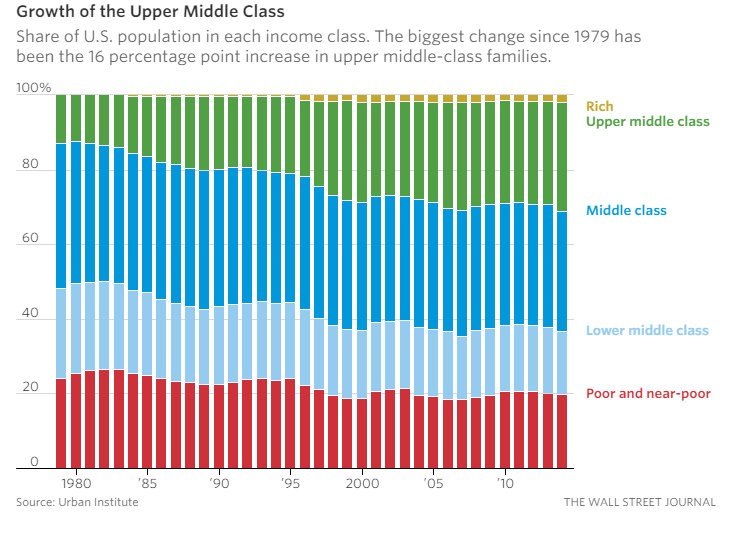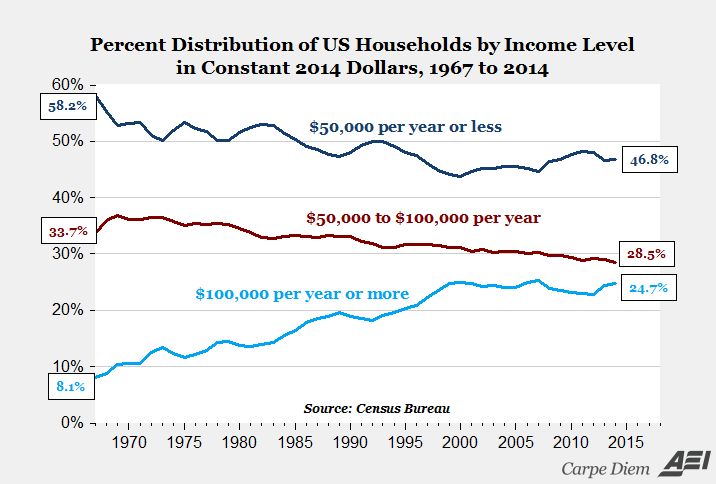The American middle class is disappearing. This is what everyone says, all the time.
Although the notion propels many political debates, it’s simply not true. At the very least, it’s a debatable proposition. Yet I can’t remember a single journalist, debate moderator, or editorial board pushing back when a politician drops the usual trope about the middle class “shrinking” or “being squeezed” or “stagnating” or being “murdered?” It’s simply a given that the middle class is under duress.
A recent piece in the Wall Street Journal looked at some fresh studies and found, once again, that the “middle class” wasn’t shrinking because Americans were moving in large numbers to the lower economic rungs, but because they were moving to higher ones and becoming wealthier. The upper middle class is growing.

According to research by Stephen Rose at the Urban Institute, in 1979 38 percent of families in the United States were in the middle class compared to only 32 percent in 2014. Despite the endless political chatter about stagnant wages, Rose adjusted thresholds for inflation going back to 1979 and found that those moving into the middle class were earning more, and earning it through contemporary middle-class vocations.
From the article:
Using Census Bureau data available through 2014, he defines the upper middle class as any household earning $100,000 to $350,000 for a family of three: at least double the U.S. median household income and about five times the poverty level. At the same time, they are quite distinct from the richest households. Instead of inheritors of dynastic wealth or the chief executives of large companies, they are likely middle-managers or professionals in business, law or medicine with bachelors and especially advanced degrees.
AEI’s Mark Perry has long argued that upward mobility over the past 50 years has been historic. Perry found that the share of American households earning $100,000 or more per year has tripled since 1967, from 8.1 percent to 24.7 percent (in 2014). At the same time lower-income households, those making $35,000 a year, fell over the same period of time by five percentage points.

Let’s set aside income for a moment. Use any measure of quality of life—college enrollment, homicide rates, vehicular deaths, infant mortality, life expectancy, workplace injuries, pollution, teen pregnancy, access to health care, just to name a very few—and you will see an improvement for a majority of Americans over the past 40 years. As the economist Don Boudreaux recently argued, today’s middle-class American probably has a materially better existence than billionaires like the Rockefellers did 100 years ago. Yet we have political movements feeding the anxieties of millions of people, promising to bring back menial labor factory jobs and unproductive union-scale work to save the middle class.
Of course it could be better. It could always be better. It would be great to have more economic mobility. Fewer poor Americans, etc. But if voters happened to obtain most of their knowledge about the nation’s economic situation by listening to political candidates, radio personalities, and cable news hosts, how many of them would know that the percentage of Americans in lower-income brackets has shrunk over the past 40 years? All they would know is that the middle class was on an inevitable decline because the rich were sticking it to them.
Liberal canon says Reagan-era reconfiguration of tax policy and economic priorities created an acceleration of inequality, “destroying the middle class.” Today’s Democrats regularly claim that the majority of growth over the past 10 to 20 years has been gobbled up by plutocrats, causing widespread harm to the economy. (This notion is also highly debatable.) I suspect that liberals, who tend to conflate inequality (which has widened) with economic growth, wouldn’t see the expansion of the middle class as much of a victory, anyway.
As Thomas Sowell succinctly put it:
Many people believe in eliminating gaps and eliminating poverty. They don’t realize that in some sense those two things are antithetical. If you were to double everyone’s income, or if everyone’s income were doubled naturally over the course of time, then you would reduce poverty significantly but you would have also increased the gap. Now, I think the guy who is having trouble feeding his family and paying the rent is not going to complain if his income doubles over time, even though that means he is further below the Rockefellers than he was before.
Alas, the volatility and risk that comes with a dynamic economy is not only a problem for Democrats. The Donald Trump phenomenon is also, to some extent, predicated on the idea that elites have unleashed economic unfairness. Protectionist ideas will always be with us because, inevitably, progress disrupts the lives of the vulnerable, who are often the last to benefit from advances in innovations and often lack the skills to adapt to a changing job market. Yet all classes benefit from the creation of wealth.
The economy is complex like that. We can let economists debate how to most accurately measure inflation, inequality, and stagnation. But the middle class is not suffering some unique or historic misfortune. Although there are plenty of challenges out there, if you’re a member of the American bourgeois, you’re probably one of the luckiest humans to ever walk the earth.









